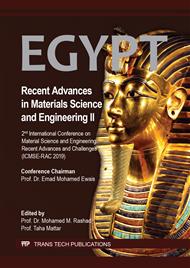[1]
Chen Peng. The nature, classification and utilization of coal in China [M]. 2nd ed. Beijing: Chemical Industry Press, (2007).
Google Scholar
[2]
China Energy Research Association released China Energy Development Report 2016, [J]. Power and Energy, 2016, (05): 640.
Google Scholar
[3]
Tao Youjun, Gao Min, Shen Zhengyi et al. Experimental Study on Centrifugal Gravity Separation and Desulphurization of Fine Coal[J]. Coal Science and Technology, 2003, 31(11): 17-19.
Google Scholar
[4]
Tao Youjun, Song Ao, Zhai Yushuai, Wang Xu, Zhu Xiangnan. Study on the characteristics of inner-membrane flow in Falcon separator under centrifugal force[J]. Journal of China University of Mining & Technology, 2016, (03): 597- 601+609.
Google Scholar
[5]
Tao Youjun, Zhu Xiangnan, Wang Xu, Song Ao, Yan Yushuai. Numerical simulation of flow field in enhanced gravity separator[J]. Journal of China Coal Society, 2016, (05): 1244-1249.
Google Scholar
[6]
Xiang-nan Zhu, You-jun Tao, etal. The low efficiency of lignite separation by an enhanced gravityconcentrator.
Google Scholar
[7]
Xiang-nan Zhu, You-jun Tao, etal. Separation of flocculated ultrafine coal by enhanced gravity separator.
Google Scholar
[8]
Tang Wengang. Fundamental theory and application of hydrocyclone [D]. Chongqing University, (2006).
Google Scholar
[9]
Li Xiaodong. Research on the Influence of Additional Mechanisms on Graded Performance of Cyclones[D]. Taiyuan University of Technology, (2013).
Google Scholar
[10]
O.D. Polulyakh, I. P. Kurchenko, et al. R&D of a combined device for hydrocyclones and in-feed flotation pretreatment screens [C]. Proceedings of the 16th International Coal Preparation Conference, 2010: 251-254.
Google Scholar
[11]
Bhaskar K U, Govindarajan B, Barnwal J P, et al. Classification studies of lead–zinc ore fines using water-injection cyclone[J]. International Journal of Mineral Processing, 2005, 77(2):80-94.
DOI: 10.1016/j.minpro.2005.02.007
Google Scholar
[12]
Honaker R Q, Ozsever A V, Singh N, et al. Apex water injection for improved hydrocyclone classification efficiency[J]. Minerals Engineering, 2001, 14(11):1445-1457.
DOI: 10.1016/s0892-6875(01)00158-3
Google Scholar
[13]
Patil D D, Rao T C. Classification evaluation of water injected hydrocyclone[J]. Minerals Engineering, 1999, 12(12):1527-1532.
DOI: 10.1016/s0892-6875(99)00139-9
Google Scholar
[14]
He Qinglang, Sheng Hongguang. Application Research of Krebs gMaxHydrocyclone in Dashan Concentrator[J]. Mineral Resources Protection and Utilization, 2007(5):35-37.
Google Scholar
[15]
R. G. Moresch, Cui Hongshan, Li Changgen. Successful application of Krebs gMax cyclone in the coal industry [J]. Abroad Metal Mineral Concentration, 2003, 40(11):12-16.
Google Scholar


